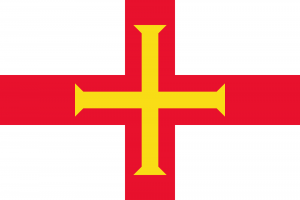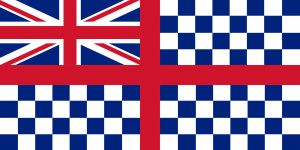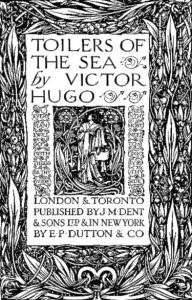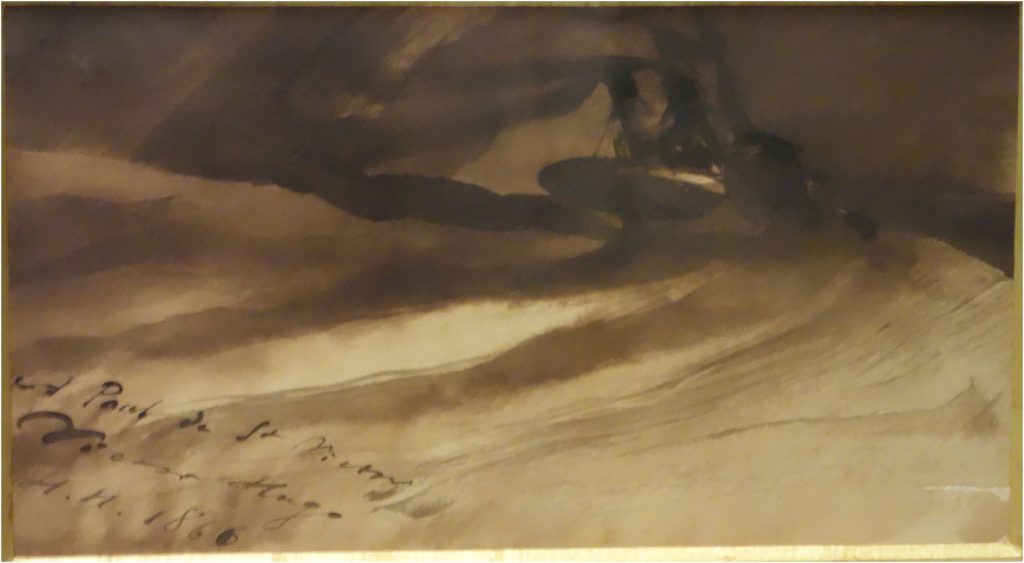Guernsey flag
Guernsey has had several distinct flags over the centuries. The present one isn’t as old as you might imagine, having only been adopted in 1985.
1985 to present day
 Guernsey’s official flag is a St George’s Cross overlaid by a gold Norman cross. The combination nods at the island’s connections to both England (latterly Britain) and Normandy. The Norman cross was the symbol of William the Conqueror, and the Guernsey flag is therefore flown in commemoration of the Battle of Hastings. It was adopted on 30 April 1985 and replaced the Union Flag as the pennant flown on Grosse Rocque throughout the year.
Guernsey’s official flag is a St George’s Cross overlaid by a gold Norman cross. The combination nods at the island’s connections to both England (latterly Britain) and Normandy. The Norman cross was the symbol of William the Conqueror, and the Guernsey flag is therefore flown in commemoration of the Battle of Hastings. It was adopted on 30 April 1985 and replaced the Union Flag as the pennant flown on Grosse Rocque throughout the year.
1936 to 1985
 Guernsey previously used simply the St George’s Cross, but this led to confusion, particularly at sporting events, when some may have thought it was being flown by an English team, rather than Guernsey. A proposal to overlay it with the Guernsey coat of arms was discounted as this would have introduced a level of detail that would have been difficult to discern at a distance.
Guernsey previously used simply the St George’s Cross, but this led to confusion, particularly at sporting events, when some may have thought it was being flown by an English team, rather than Guernsey. A proposal to overlay it with the Guernsey coat of arms was discounted as this would have introduced a level of detail that would have been difficult to discern at a distance.
Prior to 1936
 Guernsey went for some time without an official flag, but there is evidence of an earlier, 19th century design being used. This showed the St George’s Cross on a chequered field, with the Union Flag in the upper left quarter. There is some debate over whether the chequered field should be blue and white or black and white.
Guernsey went for some time without an official flag, but there is evidence of an earlier, 19th century design being used. This showed the St George’s Cross on a chequered field, with the Union Flag in the upper left quarter. There is some debate over whether the chequered field should be blue and white or black and white.
Maritime flags
Guernsey also has its own civil and merchant ensigns, which are flown on boats. The civil ensign shows the Union Flag in the upper left corner, on a red field, with the Norman cross to the right. The merchant ensign has a blue field, rather than red, but is otherwise identical to its civil counterpart.


Clameur de Haro

Clameur de Haro is an ancient saying that anyone who believes they are being wronged can utter for the purpose of having the wrongdoing stopped. It still has legal standing in Guernsey and the other Channel Islands.
It needs to be said directly to the wrongdoer and in front of at least two witnesses. It must then be lodged formally, in writing, at the Greffier, within 24 hours.
The Clameur
The core saying is short, but it must be followed by the Lord’s Prayer and, in Guernsey but not the other islands, a Grace, as follows:
Haro! Haro! Haro! A l’aide, mon Prince, on me fait tort.
Notre Père qui est aux cieux. Ton nom soit sanctifié. Ton règne vienne. Ta volonté soit faite sur la terre comme au ciel. Donne-nous aujourd’hui notre pain quotidien. Et nous pardonne nos offenses, comme nous pardonnons à ceux qui nous ont offensés. Et ne nous induis point en tentation, mais délivre-nous du mal.
La Grâce de Notre Seigneur Jésus Christ,
la dilection de Dieu et la sanctification de Saint Esprit
soit avec nous tous éternellement. Amen.
The Clameur comprises the whole of the text, but the most interesting part is the opening line, which translates as ‘Hear me! Hear me! Hear me! Come to my aid, my Prince, for someone does me wrong’.
In The Sarnian
Remus Carey uses the Clameur de Haro in book 2, Blowfish, when he’s falling from a boat. However, it wouldn’t have counted, even if he had any chance of Marie Budzinski, to whom he called, understanding: there were no witnesses and he wouldn’t have been able to lodge the complaint formally.
Modern day usage
The Clameur de Haro may seem outdated, but it’s still an acceptable legal device available for use on Guernsey. When used it is often in cases of dispute over land.
- A Guernsey couple attempted to use it in 2010 to stop the bank repossessing their property but the Deputy Bailiff refused to uphold it because the bank was deemed not to be doing wrong.
- In 2016, a campaigner intended to use it to prevent the relocation of a war memorial.
- A man read the Clameur de Haro in December 2016 to prevent planning officers removing a derelict car from his property.
Beyond the law
Clameur de Haro is also the name of a Guernsey-based bluegrass band.
Toilers of the Sea: a summary
Above: The haunted house at Pleinmont that features in Toilers of the Sea
Toilers of the Sea tells the story of Gilliatt, who lives in the Bû de la Rue, a decrepit house in St Sampson. He arrived on Guernsey as a small boy, brought there by his mother, but where she came from nobody knows. She left him the house in her will, along with a chest full of women’s clothes that she said he should give to his wife when he married.
 When he reaches the point where she stopped, he sees that she’s written his name in the snow, and he’s smitten. From that point forth, he watches her, and sometimes plays Bonnie Dundee his bagpipes, outside the house where she lives with her uncle, Lethierry. Lethierry is having none of it. He tells Gilliatt to stop wasting his time: Lethierry will never allow him to marry Déruchette.
When he reaches the point where she stopped, he sees that she’s written his name in the snow, and he’s smitten. From that point forth, he watches her, and sometimes plays Bonnie Dundee his bagpipes, outside the house where she lives with her uncle, Lethierry. Lethierry is having none of it. He tells Gilliatt to stop wasting his time: Lethierry will never allow him to marry Déruchette.
Lethierry is a retired captain, who’s invested in a steam boat called the Durande. The local fishermen hate it, calling it the Devil Boat, and so do the priests, as it’s unnatural to bring water and fire together when God has set them apart. Nonetheless, under the captaincy of the trusted Clubin, it does a good trade, taking Guernsey products to the French markets quickly enough for them still to be fresh.
If it wasn’t for the fact that Lethierry had been robbed of his fortune by Rantaine, a poor French man that Lethierry had brought to Guernsey, he’d never have needed to run the Durande at all. Lethierry has come to love his boat, though, just as much as he loves his niece. It would be his dream to find a younger captain for his boat than Clubin, who could also be Déruchette’s husband, but on the whole he would be happy for her to choose her own husband – just so long as it’s not a man of the church.
At about that time, a priest arrived on the island. Ebenezer Caudray was to take over from the rector of St Sampson, who was moving to St Peter Port. Caudray would one day come into a fortune when his uncle, the dean of St Asaph, dies – if he himself should live that long, which he almost didn’t do. Exploring the island on his first day, he sat in a seat-shaped rock close to Gilliatt’s house, where people tend to fall asleep and drown as the sea rises. The priest, too, dozes off. Fortunately, Gilliatt, who has just won a sloop in a sailing competition, sees him while he’s out in his new boat, and rescues him just in time.
On his frequent trips to St Malo in the Durande, Clubin would stay at the Jean Auberge tavern, where he met captain Zuela, a man who helps fugitives escape the law. One day, Clubin sees Zuela talking to what looks like a Quaker among the St Malo rocks and, consequently, goes to a gun smith to buy a revolver.
Back on Guernsey, three boys are looking for birds’ eggs on the cliffs around Pleinmont when they come across the isolated, supposedly haunted house up there. They overhear men inside arranging for someone else – unnamed – to wait there for transport to Torbay in England courtesy of a man called Blasquoto, who’ll be coming from Bilbao.
Later that week, back in St Malo, the Quaker comes up behind a coastguard, who has been watching a ship anchored just offshore. The Quaker kills him, and a moment later, Clubin appears – with the revolver in his hand. He identifies the Quaker as Rantaine and demands that he repays the money he stole from Lethierry, with interest. Rantaine hands over a tin box with £3000 inside it. Clubin lets him go, but Rantaine says he’ll make sure Lethierry’s informed the debt’s been repaid.
Clubin set sail in the Durande the next morning, despite being warned by the locals not to do so. All the other boats are returning to port, but Clubin presses on, telling the drunk helmsman (who is only drunk from consuming a whole bottle of brandy that Clubin had hidden where he knew the helmsman would find it), to ignore the oncoming tempest. The boat runs around in this fog on what Clubin believes is the Hanois rocks, a mile from Pleinmont. The passengers and crew evacuate, but Clubin says they’re to leave him there, alone, or else the lifeboat will capsize. This had all been part of his plan, though. He wanted to steal the £3000, so had deliberately grounded the Durande, and planned to swim from Hanois back to Guernsey. They leave him, but as the fog clears, Clubin sees that he’s not on Hanois, but the Douvres, a series of isolated rocks too far from shore to swim. Nonetheless, he must try. He dives into the sea, where something grabs his ankle and pulls him down. He never comes back up.
When news of the grounding gets back to Guernsey, everyone thinks Clubin acted like a hero. The captain of a passing ship had seen no sign of him, but did describe the Durande as being wedged between the rocks and says that the engine may be salvageable. Déruchette says she will marry any man who can recover it, and Lethierry says that he would allow such a marriage to proceed.
That night, Gilliatt heads for the Douvres in his sloop. When he gets there, he strips anything useful from the Durande and organises it into piles in a cave. He makes another cave into a forge by starting a fire and directing the airflow over a large rock to feed the flames. He then goes out in search of food, and discovers a beautiful, other-worldly grotto in which the water is lit by a phosphorescence. He spots something ribbon-like in the deepest parts, but it retreats into the darkness before Gilliatt leaves.
He manages to free the engine and lower it into his sloop, but it takes two months, and another storm is on the way. He uses old planks from the Durande to create a breakwater, and when the storm passed he has one last scouting mission for food. He follows a crab back into the grotto and puts his hand into a crevice to try and catch it. As he does, a giant octopus snares him, wrapping five of its tentacles around him arm and body, and starting to suck his blood. He has just one chance to kill it, which he does, by slashing its head with his knife. While he’s washing his wounds in the water inside the cave, he spots Clubin’s remains. The tin box containing the £3000 is still strapped to his belt.
Gilliatt takes the money and sails back to Guernsey. He returns the engine and the money to Lethierry who says that he must now marry Déruchette. However, Gilliatt overhears the rector, Ebenezer Caudray, proposing to Déruchette, and Déruchette accepting, so he refuses. Lethierry insists, and hearing this, the rector makes plans to leave Guernsey alone. Before he does, though, Gilliatt sees them in Havelet Bay and convinces him and Déruchette to marry and go together to England. They do so, and Gilliatt gives her the clothes that his mother said he should give to his wife, explaining to her that he’s unlikely to ever marry.
He goes to the seat-shaped rock by his home where he’d saved the rector’s life, and sits there to watch Déruchette and the rector sail off to England, ignoring the rising water. By the time their boat disappears over the horizon, the water has risen over Gilliatt’s head. “Nothing was visible now but the sea”.

The image above, from the Collection privée / Musée des Lettres et Manuscrits, Paris, is Victor Hugo’s own drawing of the Durande, from November 1866.
Toilers of the Sea
Victor Hugo’s Toilers of the Sea is one of the best known of all books written about – and on – Guernsey. Completed in 1866 when Hugo was living in exile in St Peter Port‘s Hautville House (below), it was originally published in French under the title Les Travailleurs de la mer.
The inscription in the front of the book reads, “I dedicate this book to the rock of hospitality and liberty, to that portion of old Norman ground inhabited by the noble little island nation of the sea, to the island of Guernsey, severe yet kind, my present asylum, perhap’s my tomb’.

Plot of Toilers of the Sea
It’s the story of Gilliatt, a Guernsey local treated by his neighbours with suspicion, until he proves his worth by salvaging a boat in the hope of marrying the boat owner’s neice (click here for a full summary on one page of Toilers of the Sea – includes spoilers).
It’s largerly realistic apart, perhaps, from a fight with a giant octopus, which is nonetheless integral to the plot. Structurally, it’s broken into three books, the second of which concerns the salvaging of the boat. The other two, which sit either side, deal with Gilliatt’s motivation and the eventual outcome.
Victor Hugo’s writing style
The book has held up well, considering its age, although Hugo does revel in detail, and includes several long tracts of opinion or stated fact that would seem out of place in modern fiction. He also guides the reader carefully, frequently reminding them that he has discussed certain matters before.
Free downloads of Toilers of the Sea
Toilers of the Sea is now out of copyright and free to download. eBook versions are available from Project Gutenberg, and the audiobook has been posted to Librivox. You’ll find them through these links:
- ePub version of Toilers of the Sea
- Kindle version of Toilers of the Sea
- Audiobook version of Toilers of the Sea
The image at the top of the post, from the Collection privée / Musée des Lettres et Manuscrits, Paris, is Victor Hugo’s own drawing of the Durande, from November 1866.
Free Guernsey computer wallpaper
Give your computer, tablet or phone a Guernsey makeover with The Sarnian’s selection of desktop wallpaper. The first collection contains five watercolour views showing off different parts of the island. They’re free to download and use in any personal capacity. Click the images below to download the wallpaper you’d like to add to your device.

Loophole tower
This tower, between L’Ancresse and Fontenelle Bay, is one of the twelve remaining towers that sit around the Guernsey coastline.

Torteval view
Looking out from a high point in Torteval, across the valley as far as the sea, where Fort Grey provides the backdrop.

Petit Bot Bay
Looking back into Petit Bot Bay from the cliff path that runs along Guernsey’s south coast, you can clearly see the beach and tower.

Marble Bay
One of Guernsey’s lesser-visited inlets, Marble Bay is hidden among the tall pine trees on the islands south east corner.

